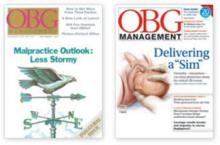“You work in a pressurized world…”—Carroll V. Dowden, OBG Management “Memo from the Editor,” Volume 1, Number 1, 1989
With this issue, and through September 2009, we celebrate the 20th birthday of OBG Management. Before you move on to read this issue, let us tell you, briefly, what this milestone means for us and, even more, for you.
The goal of good work
Our editorial staff, esteemed Board of Editors and authors have worked hard to achieve our principal goal:
- to support your professional development
- to reinforce and advance the high quality of care you provide for your patients
- to relieve some of that “pressure,” from all directions, to stay competent, grounded, and satisfied.
We believe that we accomplish that goal by publishing timely, authoritative articles that offer evidence-driven approaches to diagnosis and treatment.
In our 20th year, we’re working (as we have in the past) to have OBG Management recognized as the premier source of information for your work—in print, online, and at live meetings—whenever you need that information. And we want you to be an interactive partner in publishing by way of your feedback, contributions, and exchanges with our experts.
Our first birthday “present” in this celebratory year is for you, not for ourselves: the eye-opening and insightful cover article of this issue on how simulations of obstetrical procedures and emergencies are changing the nature of OB training and continuing education. The discussion is pertinent whether you are in training or have decades of experience behind you.
The road to your mailbox is a long and uphill one
Developing an article for publication in OBG Management is arduous.
Research. We begin by testing potential topics and titles with members of our Virtual Editorial Board and a sample of our audience at large. Those candidate topics—carefully assembled to provide a mix of obstetrics, gyn, professional liability, infertility, surgical technique, and practice management—arise from the advice of our Board of Editors and our survey of pertinent trends and developments in medicine. Roughly, only 20% of tested topics and titles are found to be of sufficient interest to warrant moving ahead to develop as articles.
Recruitment. We recruit authors who are expert on a given topic and excellent clinical educators. (On occasion, an author approaches our staff with the right topic and the right professional credentials, or our Senior Editor will undertake in-depth analysis of a newsworthy ObGyn topic.) Our full-time editorial staff work closely with these invited authors to pinpoint key educational objectives that best serve readers’ needs.
Review and revision. Draft manuscript in hand, the editorial staff 1) ensure proper review of papers by members of the Board of Editors and, as necessary, other experts, 2) obtain full compliance with requests for revision, and 3) edit the work into a reader-friendly article that highlights key changes for clinical practice in diagnosis and treatment. The design staff work with authors to provide illustrations, photographs, and other supportive visual materials.
Research again. Last, we periodically survey our readers after publication of an issue to assess the relative strengths and weaknesses of articles (“Was it of interest to you?” “Did you learn from it?”) and to identify how to continually improve our editorial process. In parallel, senior publication consultants review each issue and provide critique.
The goal of this process is, as we noted earlier, to provide you with high-quality, timely, authoritative, and practice-changing articles. Your colleagues tell us we are succeeding; still, we push to improve.
It’s leadership that’s brought success
A major force in the creation and development of OBG Management has been Carroll V. Dowden, Chairman of Quadrant HealthCom Inc.. For two decades, beginning as Editor, Mr. Dowden has thoughtfully and patiently supervised our editorial and management teams. Years spent nurturing OBG Management have been rewarded with milestones of success in readership ranking among “competing” publications. That achievement is a reflection of audience loyalty and approval, and allows us to continue to deliver a useful and readable publication.
E3 drives our work: Evidence, electronics, energy
Looking back over the past 20 years, it’s clear that the rise of evidence-based medicine has had a major impact on how we approach the development of articles and departments. “Evidence” is a major theme here—from our monthly section, “Examining the Evidence,” that focuses on reported results of practice-changing clinical trials, to the way we instruct authors to approach manuscript preparation.
Headlines on the cover of Volume 1, Number 1 (at left), reflect an early focus on practice management. But readers called emphatically for greater clinical support and guidance, shifting the publication’s mission. Today, coverage of professional liability is expanding, again in response to your colleagues’ requests. Looking forward to the next 20 years, one of our most important goals is to develop Web-based, interactive materials that support and multiply the positive impact of our articles on our readers and their patients—materials to which you can have access every minute of the day. Right now, OBG Management has a solid Web presence (at www.obgmanagement.com), with more than 15,000 viewers visiting each month, on average, to read articles and educational supplements, listen to podcasts, and watch instructional videos. We recently added a medical search engine, www.obgfindit.com , to our Web experience, where you can—without charge—search for expert-selected, high-quality material on your topic of interest, culled from our own archives and from hundreds of medical sites across the Web.


